





Published on Nov 30, 2023
In this paper, IoT based smart village system is developed to support value-added services for various attributes of the village and for the people, while it still being a broad and complex category that are characterized by specific application domain. Rural development are designed to support the Smart village mission, which aims at exploiting the most advanced communication technologies. The global focus on waste, energy and water management and conservation and the cloud based system plays a key role in extending the connected benefits of the smart village beyond the distribution, automation and monitoring being done by utility. IoT based Monitoring system will help consumers to monitor their own usage and adjust behaviours. The proposed systems will eventually regulate automatically by operating during off-peak energy hours and connect to sensors to monitor occupancy, waste collection system, lighting conditions, and also optimized irrigation management for those attributes are incorporated.
This paper will address and discuss the technical solutions for the energy management, smart irrigation system and waste management which can be adopted in the rural development mission.
There are huge challenges in realization of a rural development that monitors and integrates all of the village infrastructure and services to leverage the collective intelligence. The development of a IoT based smart village includes Cloud based network which can provide a virtual infrastructure to process and integrate the analysis tools monitoring equipment, storage, and visualization platform within the system.IT- OT convergence which intend to smart billing and data analytics in energy management. Waste collection system enhanced with cloud based IoT services which enable dynamic scheduling and routing in a waste collection system seems to be an efficient system.
The access to sustainable energy services acts as a basic catalyst for smart village development extending the provision of efficient management of energy, water, waste and various other attributes. Major parts of rural areas are not stand-alone system it remains a part of a cluster, which are related to each other. These clusters explains the potential for development and it possess economic drivers, derive
Locational and competitive advantages. Rurban is named after the development of these clusters which aims to strengthen the rural areas by provisioning of physical infrastructure, economic and social facilities.
The envisaged components in each cluster are listed below:
Mobile medical services.
Education system.
Sanitation
Water management system
Waste management.
Road system Inter village connectivity.
Lighting control
Fleet management
Digital Literacy and People Service Centres.
Economic activity based Skill development programme
Agro Processing, Agri Services, Storage and development.
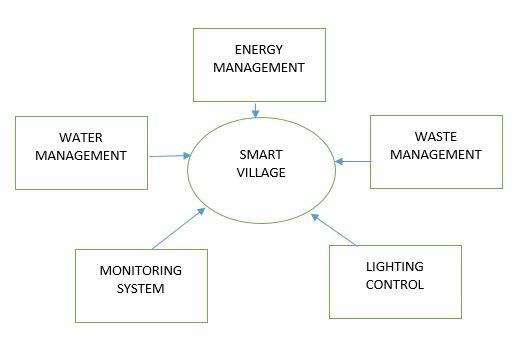
IoT based smart village can help to reduce cost through improved process efficiency, asset utilization and productivity. The tracking of devices is improved using sensors and communication devices which can be benefited from real-time datas and analytics help them make smarter decisions. The growth and convergence of data, processes and things on the internet would make such connections more relevant and important, creating more opportunities for people, businesses and industries.
Fig.1 represents the overall block diagram of the smart village system. The enormous IT infrastructure is required by rural development along with the huge financial support which is to be incorporated. Sensors, thousands of networking equipment and computing devices are built in this complex network. Operational and maintenance cost of such a complex real time system will be much higher which is evident to meet stringent reliability and efficiency improvement. In case of smart irrigation management system each field has to be fitted with a sensors and data control unit which are highly efficient and reliable.
Each country has developed a reputation as a global leader in upgrading their city as smart city initiatives in its larger urban areas. The Rural areas are in need of essential infrastructure like roads, drinking water and power. The future development mainly concentrates on improving big metropolises into connected cities but failed to see where most of the population resides. Villages more than cities need to be made smart for the overall improvement and development of the country. The Development of opportunities for youths in villages, thereby discouraging migration to cities. Farming remunerate occupation, with guidance and mentoring to farmers on how to get the best yield and market at remunerative prices for the future rural development. Proper implementation which presides over the benefits such as crop insurance, soil health card, and pesticides which can reach the grassroots. Fig.2 explains the smart village transformation.
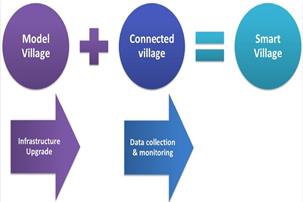
The paramount importance should be given to develop an economically viable and culturally sensitive ecosystem in villages. The challenges remain the same, direct access to the global market has been a major challenge largely due to multiple intermediaries and lack of skilled workforce. The large population lives in villages, we always fail to improve economic potential and basic services by creating smart village.
The most villages lack essential infrastructure like proper irrigation system, electricity and water. To overcome this challenge, three strategy can be followed:
Provide education on technology that supplements indigenous skills,
Ensure digital and IT awareness, and
Connect skilling-interventions to market.
Smart Village development enable and access to sustainable energy services which paves way for a development – enabling the provision of good education and healthcare, optimized energy management, sanitation, avoid wastage of water, and enhanced security, gender equality and the growth of productive enterprises to boost incomes, democratic engagement.
The challenges in load control for the power grid is now more severe than ever, due to advancement in communication layer and the creation of a two-way infrastructure for real-time communication between people and the utility. The operator of the smart grid access the information and communication technologies to enhance grid security and reliability. They enforce controllable use of energy, and incorporate various components such as green resources, distributed generator and power storage premises. Fig. 3 explains the energy management circuit diagram
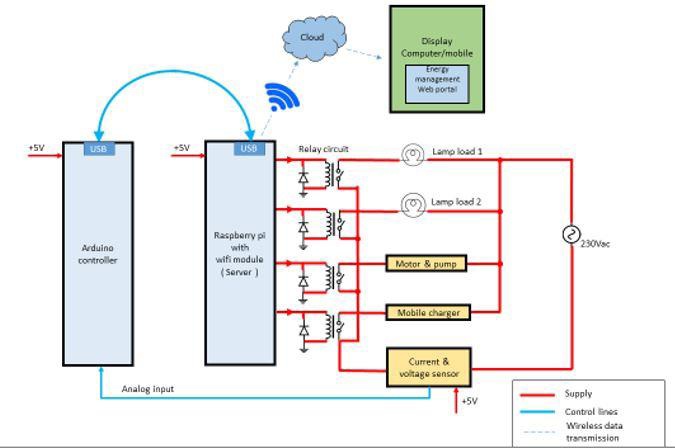
Figure 3 Circuit diagram of energy management module
Energy management is the process of monitoring, controlling, and conserving energy in a building or organization. It can also be defined as the strategy of adjusting and optimizing energy, using systems and procedures so as to reduce energy requirements
Typically, this involves the following steps:
Metering your energy consumption and collecting the data.
Finding opportunities to save energy, and estimating how much energy each opportunity could save. You would typically analyse your meter data to find and quantify routine energy waste, and you might also investigate the energy savings that you could make by replacing equipment (e.g. lighting) or by upgrading your building's insulation.
Taking action to target the opportunities to save energy. Tracking your progress by analysing your meter data to see how well your energy-saving efforts have worked.
The Demand response (DR) scheme shows that incentives are economically balanced according to the effective change of consumer behaviour. It includes minimising or shifting consumption, and using standby generation to change of electricity use from the grid to on-site generation. Notice periods of about 2-4 hours was considered by the operators as switching time to safely implement a curtail plan with minimal impact on machineries and accessories. There are various demand response [8][9] as follows
time of use (ToU)
Critical Peak Pricing (CPP)
and Critical Peak Rebate (CPR)
The agricultural productivity is dependent on efficient irrigation system. When water is spread over a wide area covering all the places and temporally distributed it matches with field water demand hence efficiency is achieved.85% of the fresh water is consumed by the agriculture and it remains dominant due to increase in population and the increasing of demand for food .Field of agriculture has seen the rapid advancement.
Irrigation system is improved by latest technologies. As precision advanced irrigation scheduling plays an important role in reduction in water wastage. The usage of various monitoring and controlled system is increased by people in order to increase the yield. Soil moisture plays a key role in the life of the plant. Nutrients in the soil solution provide the plant with the food it needs to grow. Water is also essential for regulating plant temperature through the process of transpiration. Plant root systems are better developed when growing in moist soil. Excessive levels of soil moisture, however, can lead to anaerobic conditions that can promote the growth of plant and soil pathogens.
Agricultural production is affected by poor irrigation management, it is necessary to develop strategies to optimize irrigation. The monitoring and control of various factors derived from field such as humidity, water level, temperature, and human interaction is governed by automated irrigation system. This system consists of controllers and a wireless sensor infrastructure used to transmit the detected values. The yield can be improved by various automated system which can help the farmers. Sensors can be placed anywhere in the field and system is also tested for different temperature. Only minimum deviation is observed in the sensor output. In recent years communications Infrastructure in the IoT is improved rapidly which can meet the demands between the physical world "things" and "human". Thus, the remote objects are controlled using the smart gadgets. .Fig 6 shows the drip irrigation system which is involved the smart irrigation network.
As the population in the rural areas increases, the accumulation of waste and trash level also gets increased. The conventional bins with no automation is the existing status. The time rate for dumping the waste differs for each bins bin and it doesn’t provide any details about the status.
The proper collection and disposal of these waste becomes a must. In current scenario the garbage collector physically go to each bin and check trash levels which involves more human power and wastes both time and fuel of the containers. Fig. 8 explains the waste management circuit diagram
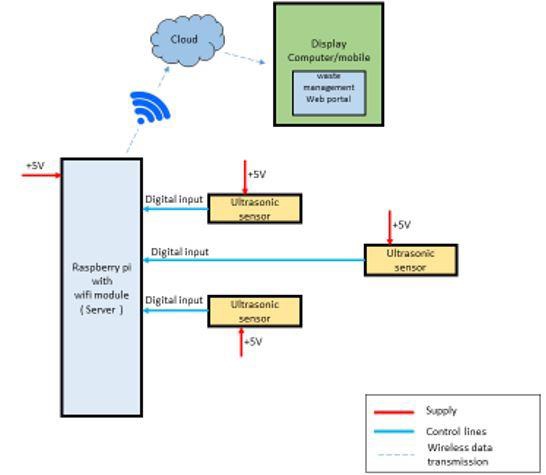
Figure 8 Circuit diagram of waste management module
The sensors interfaced waste bins , are capable of intimating waste level status, is not a novel method, the aim is use cloud interfaced network to automate the waste bins and efficiently manages the waste collection. It is not limited to the notification alone. The waste management technique which are not managed efficiently may cause serious environmental problems and increase in cost occurs. Therefore, in this paper, by developing an optimising route for the waste collection is extended to reduce the fuel cost, source through an IoT-based smart waste management (SWS). Fig.9 explains the optimised route for the smart waste collection system. It is achieved with the help of smart bins. The conventional bins specifically designed and allotted with the sensors behaves as a smart bins. These sensors are powered with the batteries or green energy sources can be used. These wireless sensors monitors, provide data at every instant and sends signal to the control center through the cloud. A specific portal is developed for the monitoring and control of the waste with the help of a centralized hub.
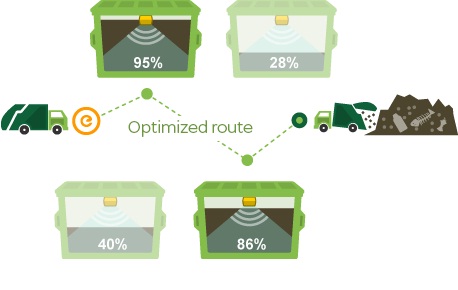
A secured cloud based server has been created with the help of this central hub. This receives data from all the sensors through wireless communication which gives a limited access for the user to monitor and control his residence appliances. The government or the central power has full access for monitoring of all attributes and also controlling of the attributes.
The advancement in wireless communications and embedded systems opened a new way for health monitoring system. Remote health monitoring using wearable technologies like sensors and smartphones is one of the most challenging interventions in aid of smart village which are in remote areas. The health care monitoring communication architecture that paves way for stationed nurses and medicine units. Sensor to patient smartphone through wearable interface.
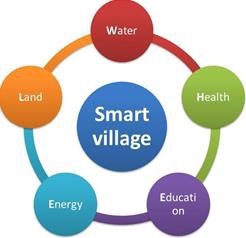
Fig.10 explains the other attributes of smart village. A secured server has been created with the help of this central hub using Node-red. This receives data from all the sensors through internet technology which gives a limited access for the user to monitor and control his residence appliances. The government or the central power has full access for monitoring of all attributes and also controlling of the attributes. The server here shows the following attributes as menu
The technology advancement in various fields of life has created a sophisticated service delivery. The aim of all these techniques in energy management is optimal balancing of supply with demand in which undesired blackouts and outages are eradicated. For successful implementation of demand response technique, modern equipment has to be implemented the rural areas. The automation in irrigation will be ensured at low cost and high accuracy which minimize the water consumption.
With the increasing population and changes in the lifestyle, cloud based waste management is another division where current technologies can be applied in a more constructive way for disposal of waste related to hygiene and resource management. This project meet out many facets of rural development and design which includes energy, environmental, economic impact using various technologies.
The basic design criteria involves consideration of all available energy sources, devices, tools and the economics of the proposed system. The impact of the design on the rural community and the need for the automation is also addressed in this paper. In the future, this work can be extended in the context of various other attributes in the cluster mentioned above.
[1] Marceau, Jane. "Introduction: Innovation in the city and innovative cities”. Innovation: Management, Policy & Practice 10.2-3 (2008): 136-145.
[2] A. P. Castellani, M. Dissegna, N. Bui, and M. Zorzi, “Web IoT: A web application framework for the internet of things,” in Proc. IEEE Wireless Commun. Netw. Conf. Workshops, Paris, France, 2012.
[3] R. Bonetto, N. Bui, V. Lakkundi, A. Olivereau, A. Serbanati, and M. Rossi, “Secure communication for smart IoT Objects: Protocol stacks, use cases and practical examples,” in Proc. IEEE IoT-SoS, San Francisco, CA, USA, 2012, pp. 1–7.
[4] P. Suresh, “Understanding Challenges in e-Governance,” Better Account with e-governance, pp. 61–63, 2011.